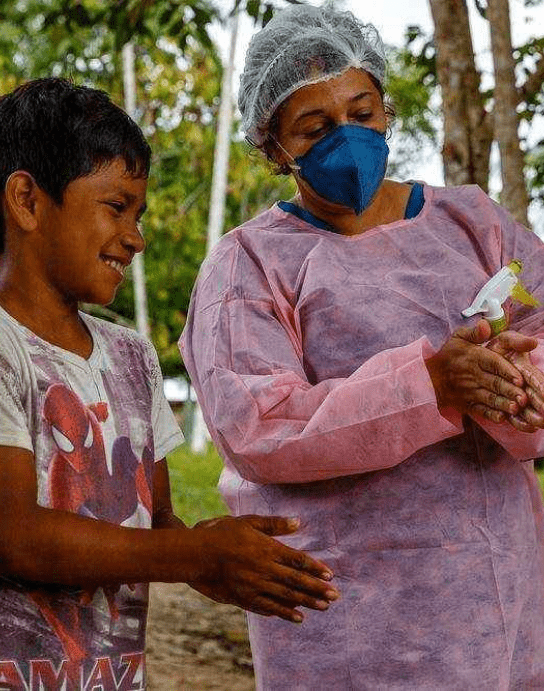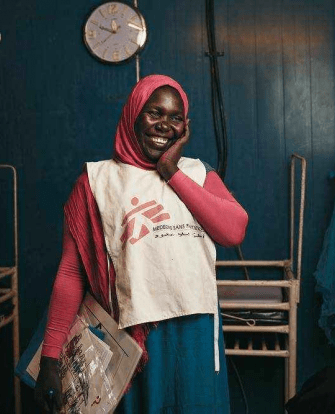Originally published on June 5, 2024
Doctors Without Borders/Médecins Sans Frontières (MSF) helps people all over the world regardless of their immigration status or political affiliation. From migration routes in the Americas, aboard our search and rescue ship in the Mediterranean Sea, or in camps for people displaced by conflict in places like Chad and Sudan, our teams provide care to those who have fled their homes in search of safety, opportunity, and a better future.
People fleeing their homes must contend with both the harrowing challenges of migration itself—like the risk of violence and securing food, water, medicine, and shelter—and harmful deterrence policies put in place by governments trying to keep out asylum seekers and other people on the move.
Here, we'll explore the distinctions among migrants, asylum seekers, refugees, internally displaced persons (IDPs), and immigrants, and discuss the ways MSF teams care for people who have been uprooted.Who is a refugee?
A refugee is a person who has crossed a national border to another country to escape conflict or persecution due to their race, religion, nationality, or membership of a particular social group. Per the UN Refugee Agency, a refugee is unable or unwilling to return to their country of origin owing to a "well-founded fear” of further persecution or harm. Signatories to the Geneva Conventions like the United States are obligated to take in refugees who arrive at their borders. They should not be expelled or sent back to their country of origin.
Refugee status is a legal determination. People who cross a border for their safety are first classified as asylum seekers and must apply, often through UN agencies, to be officially recognized as refugees. Depending on the country in which they’re applying, they may have to wait several years to know if they can attain refugee status.
Qusay Hussein is a member of the board of directors of MSF USA, and also came to the United States as a refugee, after being treated in Jordan for injuries sustained in a suicide bomb attack in his native Iraq. Qusay currently is studying for his PhD, and advocates for refugees as well as people with disabilities.
"The planet can fit all of us, and we can live in peace and love….No one can take another’s resources. Whatever God has for you, you will have it that day. If you run all the day, you’ll never get one dollar more than what God has planned for you.”
Sudanese refugees in Chad
Among the more than 8 million people displaced by the war in Sudan are nearly 2 million who have fled across borders, including nearly 600,000 to neighboring Chad. There, scarce resources in host communities and a lack of humanitarian aid contribute to health issues including malnutrition. MSF has set up mobile clinics to help Sudanese refugees access health care and our teams provide outpatient treatment for acute malnutrition, among other services.
Learn more about our work with Sudanese refugees >

Who is an asylum seeker?
An asylum seeker is a refugee who seeks longer-term legal harbor in another country, applying for sanctuary (asylum) in hopes that the country will grant it. Though national laws differ, countries are obligated to review asylum applications in due time—but “due time” is a subjective measurement, and asylum seekers are often held in detention until their applications are reviewed.
Asylum seekers at the US border
For more than 10 years, MSF teams working near the US-Mexico border have witnessed first-hand the impact of the US government’s increasingly harsh immigration policies that continue to prevent people from seeking asylum. Along the migration route, and particularly in northern Mexico, we provide care to asylum seekers and other people on the move and have witnessed an increase in people seeking care following kidnappings, attacks, and sexual violence. The people we meet have left everything behind in search of safety and the chance of a better life.
On June 4, President Biden signed an executive order essentially stopping asylum at the US southern border with Mexico, temporarily shutting down asylum requests once the average number of daily encounters exceeds 2,500 at official ports of entry. Arbitrarily shutting down asylum at the US southern border will only exacerbate humanitarian needs and expose those seeking safety to insecurity along the US-Mexico border and in other locations on the migration route.
Learn more about our work with asylum seekers at the US-Mexico border >

Who is a migrant?
Whether due to climate change, political instability, or economic conditions, migrants are people who choose to travel to another country in search of opportunities or for reasons other than physical safety.
Countries often do not offer migrants the same protections afforded to refugees, because a migrant is considered to have traveled voluntarily and would be able to return to a home country safely. For this reason they also may be ineligible to receive many types of aid.
In the Americas, the Mediterranean Sea, and beyond, migrants are taking increasingly dangerous routes to avoid detection by local authorities. By the time they reach their destination, many have experienced detainment, persecution, or violence, including sexual and gender-based violence.

Migrants crossing the Mediterranean Sea
Each year, thousands of people risk their lives to cross the Mediterranean Sea to Europe, with many leaving from ports in Libya and Tunisia. Many end up drowning or go missing as the shoddy boats frequently capsize. As of early June, more than 62,000 people had arrived in Europe via the sea, with an estimated 613 missing or dead so far in 2024, according to UNHCR. They are up against hostile European policies meant to discourage migration. Since 2017, the EU and Italy have supplied and trained the Libyan Coast Guard to stop arrivals to Europe, and force the return of people to Libya, where they face physical and sexual violence, forced labor, indefinite detention, and extortion. Other European deterrence policies obstruct humanitarian search and rescue operations, normalize violence against people on the move at borders, and subject them to inhumane detention conditions.
MSF teams provide care to migrants and other people on the move once they reach European shores and from aboard our search and rescue ship, Geo Barents, rescuing people from boats in distress in the central Mediterranean and offering survivors primary as well as mental health care support.
Learn more about the impact of European migration policies >
People on the move, explained
Refugees, asylum seekers, migrants, and internally displaced people: We might have heard these words before, but what do they mean? And what circumstances could push someone to leave their home?
Who is an internally displaced person?
An internally displaced person (IDP) has been forced to flee home for the same reason as a refugee or asylum seeker but remains in their own country. IDPs are not eligible for protection under international refugee law or eligible to receive many types of aid, since they remain within the jurisdiction of their own national government.
IDPs face similar challenges as refugees, including limited access to medicines and mental health care, and vulnerability to sexual violence.
Although they remain within their country of origin, IDPs face uncertainty regarding when they can return to their homes. Our teams are working to assist IDPs in many countries, including in Ukraine, Sudan, and Palestine.
“We left our village because robbers came, blocked the road, abducted two people and brutalized others before leaving,” Zainab Aliyu, 20, an IDP from Zamfara state in northwest Nigeria told MSF. “We had to flee because although they abducted five people, they actually were looking for 20. That was why everyone fled. Some of us had nowhere to go. So when we heard that there was an IDP camp here, we came.”

IDPs in the Democratic Republic of the Congo
In Democratic Republic of Congo (DRC), fighting between the Congolese army and its allies against the armed group M23 has forced an estimated 1.5 million people from their homes.
Throughout 2022, fighting was concentrated in Rutshuru territory, North Kivu. An escalation of violence in South Kivu province this February has driven another exodus of civilians, many of whom were already displaced by the conflict in neighboring North Kivu. Many have settled in camps around the capital city of Goma, where they live in makeshift shelters without adequate access to water, hygiene, and food.
MSF has set up emergency interventions for displaced communities in DRC. Our teams are running mobile clinics and supporting essential care in health centers near displacement sites, including care for sexual and gender-based violence. We also build latrines and distribute water and relief items such as hygiene and cooking kits.
Learn more about what's happening in DRC >
Gaza: Where to go when 85 percent of the population is displaced?
Over seven months of war in Gaza, an estimated 85 percent of the population has been displaced, fleeing constant bombing and evacuation orders by Israeli forces. For most people, access to food, medical supplies, and water is dependent on aid, which has been severely restricted since October 2023, as all aid trucks are subject to multiple lengthy inspections at several points between arrival in Egypt and eventual loading at the Rafah border, taking at least four weeks on average.

What does it mean to be stateless?
Many conversations around refugees, asylum seekers, migrants, and IDPs operate on the assumption that the people in question have a “home” nationality. For many people around the world, however, this is not the case. In some cases, no country recognizes them as citizens—including the country they call home. This makes a person stateless. Stateless people can be among any of the groups mentioned above, and their lack of citizenship can further complicate their health and safety.

Stateless Rohingya
In Myanmar, a 1982 law stripped members of its minority Rohingya ethnic group of their citizenship. Since then, it has been extremely difficult for Rohingya people within Myanmar to access health care and education or to move about freely between towns and villages.
The continued denial of citizenship in Myanmar means they are legally stateless. One of the many implications of statelessness is the inability to obtain identification documents and passports, meaning there are no safe, legal pathways for Rohingya people to seek asylum in the region, leaving them with no other option but to take risky journeys, relying on human trafficking networks that put them at higher risk of violence, extortion, sexual assault, and even death.
Learn more about our work with the Rohingya people >
Who is an immigrant?
An immigrant is a person who has moved to another country as a permanent resident. Migrants can become immigrants if they take up permanent residence in the country.
We speak out. Get updates.
Reasons for forced migration
There are many reasons people flee their home, including conflict, persecution, natural disaster, political repression, and lack of economic opportunity. Fleeing home represents a desperate necessity rather than a choice and comes with additional challenges along the way. MSF works to alleviate these challenges and the profound negative health impacts caused by forcible displacement.
Learn more about our work supporting displaced people >>
How you can help
Not everyone can treat patients in the field. But everyone can do something.
Some humanitarian crises make the headlines—others don’t. Unrestricted support from our donors allows us to mobilize quickly and efficiently to provide lifesaving medical care to the people who need it most, whether those needs are in the spotlight or not. And your donation is 100 percent tax-deductible.




